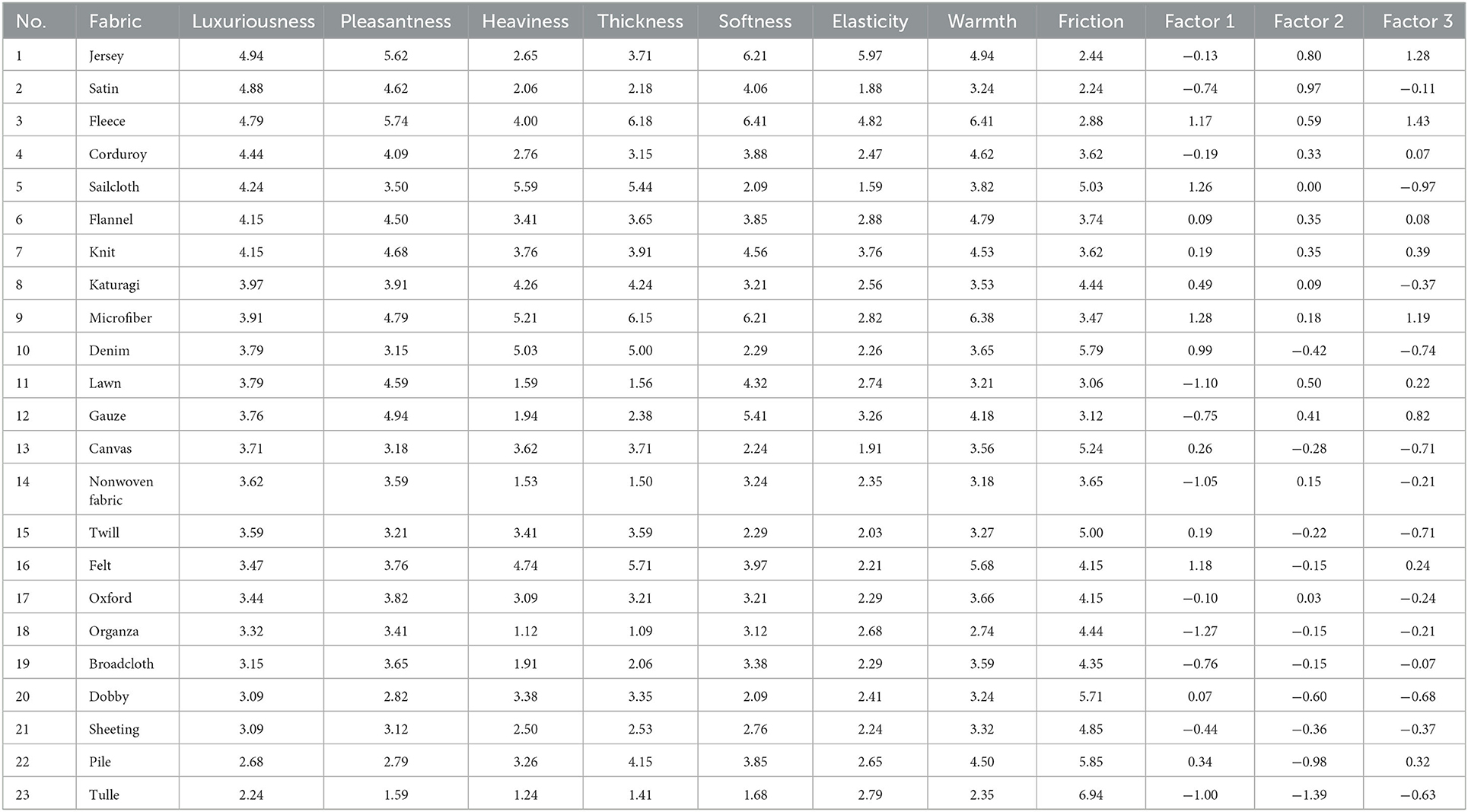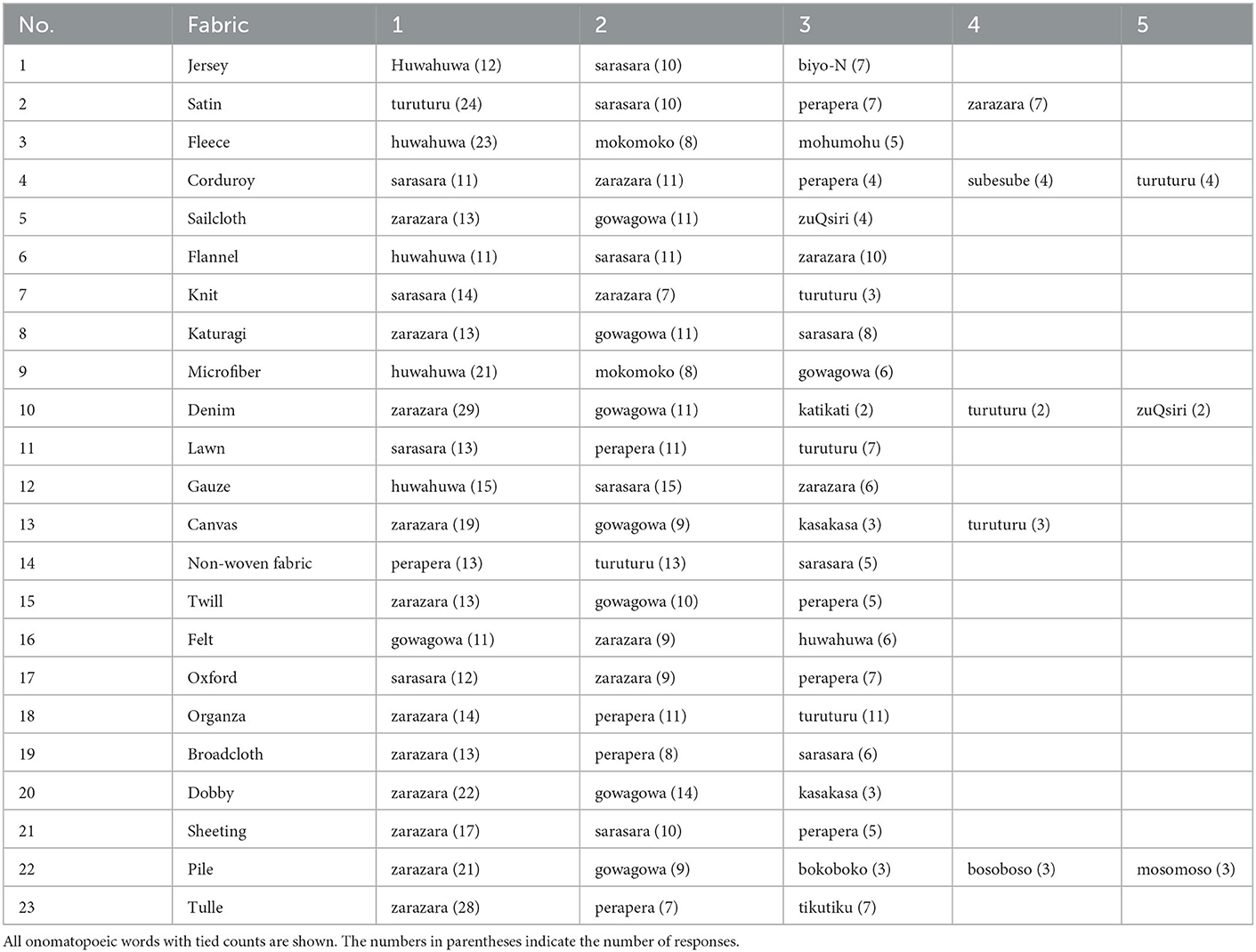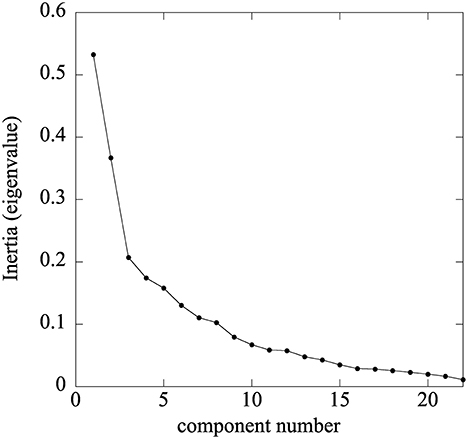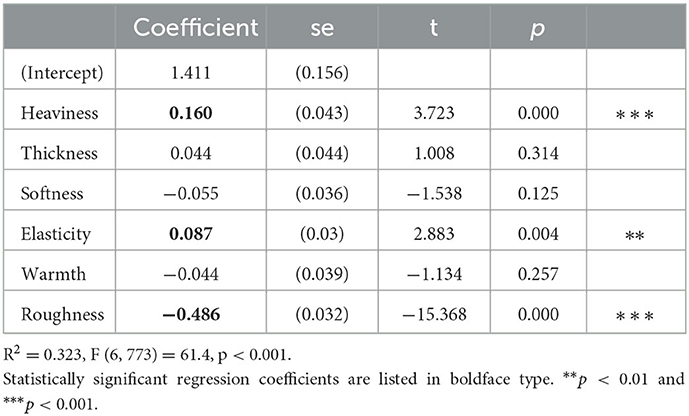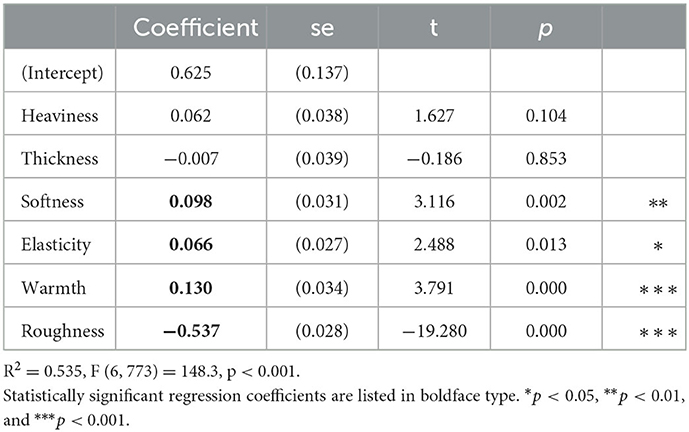- Department of Complex and Intelligent Systems, Future University Hakodate, Hakodate, Japan
This study examined the perceptual dimensions in the tactile perception of fabrics (cloths). The participants were asked to touch, stretch, and curl 23 fabrics and report suitable onomatopoeic (mimetic) words to describe the hand feel for each fabric. The participants' responses were collated into a contingency table of fabrics according to onomatopoeic words. The participants also rated the hand feel of the fabrics using bipolar semantic differential (SD) scales (heavy-light, thick-thin, soft-hard, elastic-inelastic, warm-cold, rough-smooth, luxurious-cheap, and pleasant-unpleasant). Three dimensions of thickness/heaviness, roughness, and softness were derived by factor analysis of the SD ratings with varimax rotation. Next, the dimensions of warmness/fullness/softness, roughness-smoothness, and elasticity/softness were obtained through correspondence analysis combined with sparse coding applied to the contingency table of fabrics by onomatopoeic words. However, these dimensions were not consistent with the factor dimensions obtained using factor analysis, which suggests that Japanese onomatopoeic words express the complex hand feel of fabrics. Finally, the luxuriousness and pleasantness of fabrics were also examined, and sensory characteristics and phonemes of onomatopoeic words related to these attributes were reported.
1. Introduction
Historically, humans have used fabrics as materials, and modern people cannot live without cloths. We wear, wipe our bodies with, sleep on, and wrap objects with cloths. Thus, our bodies are in contact with cloths every moment of the day. The hand feel of fabrics obtained from our tactile senses affects our quality of life. Humans have used numerous natural textiles, such as wool, cotton, and silk, and synthetic textiles, such as Nylon and Polyester; and various types of fabrics made from textiles, depending on the purpose for their use. Several studies—aiming to develop new fibers and textiles for fabrics—have been conducted. The weaving and sewing conditions of textiles also affect the touch feel of cloths; for example, it was reported that plain weave structure has higher thermal resistance than satin weave structure (Özdemir, 2017), which suggest that plain weave is appropriate for cold environments; the sewing conditions affect seam characteristics, and thereby apparel performance depends on the sewing conditions (Choudhary and Goel, 2013; Sun, 2018). The subjective assessment of fabrics obtained from the sense of touch is termed fabric hand feel or fabric handling in studies on fabrics. Fabric hand feel can be obtained through subjective evaluation or objective evaluation. For the subjective evaluation, fabrics are evaluated by hands of humans, which are usually fabric experts or trained panelists, and fabrics hand feel are assessed based on tactile perception. The subjective evaluation is sometimes performed visually (e.g., Kanai et al., 2011; Tadesse et al., 2019). The validity of the subjective evaluation has been discussed (Slater, 1997; Valatkiene and Strazdiene, 2006; Sülar and Okur, 2007; Kandzhikova and Germanova-Krasteva, 2016; Tadesse et al., 2019), and there are some guidelines for the subjective fabric evaluation (e.g., American Association of Textile Chemists and Colorists (AATCC), 2006). For the objective evaluation, mechanical and surface properties of fabrics are measured using instruments, from which the fabric hand feel is predicted. Several instrumental evaluation systems using mechanical and surface properties of fabrics were developed for the objective judgment of fabric hand feel (Behery, 2005). Fabric researchers have also developed the methods for predicting fabric hand feel from mechanical and surface properties of fabrics using more advance machine-learning technique such as fuzzy logic, artificial neural network, and fuzzy neural network (Park et al., 2000; Wong et al., 2003; Zeng and Koehl, 2003; Yu et al., 2010).
The characteristics of fabrics that influence fabric hand feel are complex. These include mechanical properties, such as tensile, shear, and compression, and surface properties, such as roughness and friction. These properties can be measured using instrumental devices while humans can judge these characteristics by touching and handling (e.g., stroking, stretching, and compressing) fabrics.
Fabric hand feel is related to several mechanical and surface properties, and can be sensed by haptics and expressed using numerous perceptual terms, which have been used for judging scales of fabric hand feel. Some attempts have been made to reduce these multiple judging scales to fewer perceptual dimensions, thereby enabling a better understanding of the perceptual system for examining the feel of fabrics. The reduction of judging scales to fewer dimensions is also useful in allowing us to more effectively express the touch feel of fabrics. Several studies have extracted tactile dimensions of fabrics. Soufflet et al. (2004) derived three perceptual dimensions of fabric hand feel (soft-harsh, thin-thick, and supple-stiff) from novice and expert evaluation data of fabric hand feel. Fernandes and Albuquerque (2008) revealed that one perceptual dimension can sufficiently describe similarity data for wool fabrics using multi-dimensional scaling. One pole of this dimension was related to thick, warm, and resistant feelings while the other pole was associated with delicate, light, smooth, soft, and flexible feelings. Consequently, this dimension was extracted only from the data for wool fabrics and not from the date for other fabrics, such as cotton and polyester. Lee and Sato (2001) examined the visual perception of textile textures by extracting three factors (voluminous and warm feeling, glossy feeling, and fine feeling) from the scores of the paired comparisons between two textile samples using the 12 scales of paired adjectives. However, their study only used the data of visual judgment as opposed to tactile judgment. Japanese experts on fabric hand feel have employed special terms that are unfamiliar to most Japanese people, such as Koshi (stiffness), Numeri (smoothness), and Fukurami (fullness and softness) (Kawabata, 1980). These terms have been considered appropriate to express fabric qualities and are related to the total quality of textiles. The Kawabata Evaluation System of Fabrics (KES) is an instrumental assessment system that quantifies fabric material tactile qualities based on the estimates of the characteristics from instrumental measurements of fabric mechanical and surface properties related to comfort (Kawabata and Niwa, 1989).
Psychological dimensions of tactile perception that are not limited to fabrics or textiles have been examined (e.g., Yoshida, 1968a,b; Hollins et al., 1993; Picard et al., 2003; Gescheider et al., 2005; Bergmann Tiest and Kappers, 2007; Yoshioka et al., 2007; Guest et al., 2011). Okamoto et al. (2013) reviewed these studies and proposed that the tactile perception of textures is expressed by three basic psychophysical dimensions—namely, roughness–smoothness, hardness–softness, and coldness–warmness. The roughness dimension can be divided into two dimensions, that is, macro and fine roughness. Furthermore, a frictional dimension related to moistness-dryness and stickiness-slipperiness can be added. Although the dimensions of Okamoto et al. (2013) involve general tactile dimensions, these dimensions are also relevant and may be important for the fabric hand feel.
Tactile sensations are often expressed by onomatopoeic (mimetic) words in the Japanese language. Research has suggested that onomatopoeic words have a wider variety than adjectives in evaluating object surfaces by touch (Watanabe and Sakamoto, 2012). Fabric hand feel cannot be expressed well without onomatopoeic words in Japanese, and Japanese often use onomatopoeic words to describe fabric handling. Thus, this study examined fabric hand feel using Japanese onomatopoeic words.
Japanese onomatopoeic words are generally classified into two groups, namely, Giongo, which imitates real sounds, and Gitaigo, which depicts non-auditory sensory impressions, states, movements, or events mimetically by sound patterns. Various derived onomatopoeic words can be generated by lengthening vowels, adding a geminate cluster (i.e., developing a consonant as a double consonant), and duplicating them. The derivative families of onomatopoeic words often represent similar meanings with subtly varying connotations.
In the Japanese language, it is widely believed that an independent category of onomatopoeic words exists. By contrast, Indo-European languages do not generally have such linguistic classes of onomatopoeic words. However, there are several sound-symbolic words—such as “glitter,” “click,” “mumble,” “thump,” and “twinkle”—in English. Onomatopoeic expressions mimicking sounds are often considered childish in English, whereas onomatopoeic words are not regarded as immature expressions in Japanese. Japanese onomatopoeic words are believed to possess rich connotative meanings that are used to describe objects and events vividly and expressively. Furthermore, studies have suggested that sound symbolism facilitates infant language learning (Imai et al., 2008; Asano et al., 2015).
Japanese onomatopoeic words have been used for psychological dimensions of perception. Hanada (2016) examined visual material perception using Japanese onomatopoeic words. This study's participants reported suitable onomatopoeic words to describe materials of objects, and the data were analyzed using correspondence analysis. Furthermore, the obtained configurations reflecting the correspondence between onomatopoeic words and materials were rotated using the sparse coding. Most psychological dimensions of the final configuration space roughly corresponded to the tactile dimensions of Okamoto et al. (2013), though the material characteristics were visually judged. Thus, these results suggest that tactile feelings are more essential than visual properties for material perception. Similarly, food textures were examined using Japanese onomatopoeic words, and 15 dimensions of food texture were obtained from the participants' responses to onomatopoeic words that described the food texture inferred from food photographs (Hanada, 2020). The high dimensionality of food texture indicates not only that food texture is complex but also that Japanese onomatopoeia is highly expressive.
This study examined the tactile dimensions of fabrics. This study's unique feature was the use of onomatopoeic words and ratings of adjective-pair scales. Although some studies have used Japanese onomatopoeia to derive perceptual dimensions of haptics (e.g., Sakamoto and Watanabe, 2017), the use of onomatopoeic words was not common for deriving tactile dimensions. Furthermore, pre-defined scales of onomatopoeic words have been used for the ratings in those studies. The selection of these scales may be affected by the experimenters' assumptions, which could influence participants' responses. In this study, participants were asked to voluntarily generate a suitable onomatopoeic word to describe a fabric to obtain responses that were not affected by experimenters' assumptions. Notably, this study applied correspondence analysis with a sparse-coding technique. This technique's usefulness has been underscored in the aforementioned studies.
The instrumental measurement system of fabric hand feel is intended to evaluate hand feel quality objectively. The fabric's hand feel quality should be associated with comfort and pleasantness. Luxuriousness—directly associated with the fabric's quality—should be evoked by comfort and pleasantness. This study examined fabrics' luxuriousness and pleasantness perceived through touch. We investigated and gained valuable psychological insights regarding the characteristics related to—and the phonemic characters of onomatopoeic words associated with—fabrics' luxuriousness and pleasantness; moreover, we obtained useful information regarding the sound symbolism of Japanese onomatopoeia.
2. Materials and methods
2.1. Apparatus
The experiment was conducted in a partitioned area of a room. A wooden box was placed on a table, and a section from the box was removed, enabling participants to touch a fabric (cloth) in the box without seeing it (Figure 1). The participants could not see the room on the other side from above or outside the box as curtains were used as shields, and the participants could not view any fabrics used as stimuli before and during the experiment.
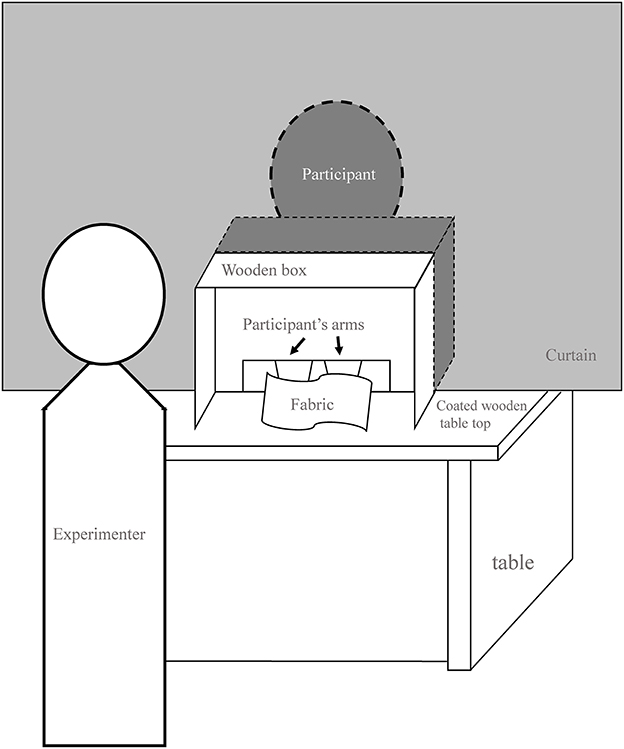
Figure 1. Schematic drawing of experimental setting. Participants touched a fabric in the box from which a section was removed. Curtains were used as shields to prevent them from seeing the fabric.
2.2. Participants
Japanese undergraduate or graduate students (19–25 years old, mean = 21.4, SD = 1.05, 17 females and 17 males) of native Japanese speakers participated in the experiment. All participants were unaware of the study's purpose and were majoring in information sciences.
2.3. Stimuli
This study included 23 kinds of fabrics. Table 1 presents the names of the fabrics that were used for their sale, and that did not necessarily indicate materials or weaving ways. These fabrics were selected from materials frequently used in daily life to ensure greater variation among characteristics such as softness, elasticity, and heaviness. The fabrics' size was about 20 cm × 20 cm. Each fabric was changed after seven or eight participants participated in the experiment.
2.4. Procedure
The participants were asked to insert their hands while ensuring that the palm side faced upward. Thereafter, the experimenter placed one sheet of fabric in their palms and asked them to touch, stretch, pinch, and curl the fabric as much as they liked. The participants were told to touch the fabric well to become familiar with its characteristics. Any standard hand evaluation technique in textile and fabric technology was not used to evaluate fabric hand feel, because these standard techniques are generally for experts or trained panelists to evaluate fabric products accurately, while the objective of this study is to examine tactile sensation of fabrics of ordinary untrained people. The participants were required to verbally report as many onomatopoeic words suitable to describe the fabric's touch feel; the reported onomatopoeic words were recorded by the experimenter. They had to report at least one onomatopoeic word for each sheet of the fabric. They were allowed to use the same onomatopoeic word for different fabrics. After reporting the onomatopoeic words, the participants evaluated the fabric's characteristics, such as heaviness and thickness using bipolar semantic differential (SD) scales of adjective pairs: heavy–light (heaviness), thick–thin (thickness), soft–hard (softness), elastic–inelastic (elasticity), warm–cold (warmth), rough–smooth (roughness), luxurious–cheap (luxuriousness), and pleasant–unpleasant (pleasantness). The participants experienced two practice trials using Fleece (No. 3 in Table 1), which was relatively thick, and Lawn (No. 11 in Table 1), which was relatively thin, to familiarize the experimental task and establish internal standards for thickness. The sheets of the fabrics used for the practice differed from the sheets used in the experimental trials. The order in which fabrics were presented was counterbalanced. However, the counterbalance was incomplete because the number of participants was not a multiple of the number of stimuli.
3. Results
The seven-step responses of SD data were numerically expressed as integers from 1 to 7. The mean ratings of the SD scales for the fabrics were averaged across the participant and are presented in Table 1.
3.1. Factor analysis of SD ratings
Factor analysis was applied to the SD ratings. Although the SD data were three-way (participants × scales × fabrics) data, the data of all the raters across all the fabrics were stacked. Consequently, the number of samples was 782 (34 raters × 23 scales). The correlations coefficients between the stacked SD ratings were calculated (Supplementary Table 1), and factor analysis was conducted using the correlation matrix. Three factors were extracted based on the Guttman-Kaiser criterion, which determined the number of factors as the number of eigenvalues of the correlation matrix >1. Thereafter, the extracted factors were rotated by the varimax method, which is one of the most popular orthogonal rotation methods. It should be noted that orthogonal rotation methods assume that factors are uncorrelated. The factor loadings and the commonalities are also exhibited in Table 2. The first factor demonstrated large loadings in terms of the thickness and heaviness of the scale in addition to a moderately large loading on warmth. Hence, this can be interpreted as the thickness/heaviness factor. The second factor was strongly related to the roughness, luxuriousness, and pleasantness scales. Since luxuriousness and pleasantness would be derived from roughness (as shown later), this factor should be termed the roughness factor. The third factor was strongly related to the softness scale and moderately related to warmth and elasticity. Consequently, this scale has been termed the softness factor. Table 1 presents the mean factor scores for the fabrics.
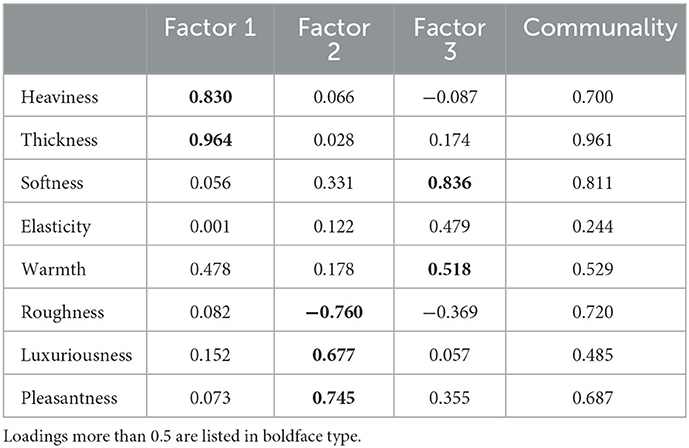
Table 2. Factor loadings and communalities of factor analysis applied to the semantic-differential ratings.
3.2. Correspondence analysis of reported onomatopoeic words
The mean number of onomatopoeic words for a fabric reported by a single participant was 2.02. The reported onomatopoeic words were transcribed into Roman alphabets using the Kunreisiki system except for the geminate clusters (double consonants), which are indicated by “Q” in the studies of Japanese onomatopoeic words (Hamano, 1986; Akita, 2009); the long vowels, which are represented by “-”; and the mora nasal, which is represented by “N.” We obtained a total of 207 onomatopoeic words.
Table 3 presents the three most frequently-selected onomatopoeic words for each fabric. Since all onomatopoeic words with tied counts are shown, there are more than three onomatopoeic words for some fabrics. The onomatopoeic word zarazara, which indicates the rough feeling of touch, was selected most for several fabrics, and sarasara, which describes a smooth surface, also appeared frequently. These findings suggest that roughness-smoothness is a key dimension of the touch feel associated with fabrics. The onomatopoeic words, huwahuwa, which represents softness, and perapera, which means thinness, were also used to describe numerous fabrics. This indicates that softness and thickness are also important for fabrics' tactile perception.
Using all participants' responses, we created a contingency table of 23 fabrics using the 207 onomatopoeic words. Next, 127 onomatopoeic words were eliminated because they were reported by only one person and, hence, would be idiosyncratic; overall, 80 onomatopoeic words were retained. Thus, a contingency table of fabrics expressed by 80 onomatopoeic words was obtained, and correspondence analysis was applied to that table using the R package “ca” (Nenadic and Greenacre, 2007). Figure 2 presents the inertia values (eigenvalues) of the analysis. Thus, this plot suggests two dimensions based on the large gap between the two and three dimensions. However, to avoid losing useful information by reducing dimensions excessively, we adopted a three-dimensional solution. Additionally, the three dimensions provided clear interpretations for the axes rotated by the procedure explained below. The three dimensions explain approximately 48% of the total inertia.
The three-dimensional configurations were plotted as a symmetrical biplot. The configurations in the first and second dimensions are presented in Figure 3A, while the configurations in the third and first dimensions are presented in Figure 3B. For visibility, the onomatopoeic words with absolute coordinates ≤ 0.8 on either the horizontal or vertical axis have been indicated using dots. The configurations' branch-like structure can be observed in Figure 3A, which reveals that the dimensional axes do not align with the branches' directions. Correspondence analysis is a type of principal component analysis with different data standardization (Clausen, 1998). Studies on signal processing have reported that the axes of principal component analysis (i.e., the direction of eigenvectors) would not typically represent the source signals that generated the observed signals. However, source signals can be recovered through independent component analysis or sparse coding representation, which rotated the axes obtained using principal component analysis (Hyvärinen et al., 2001; Stone, 2004).
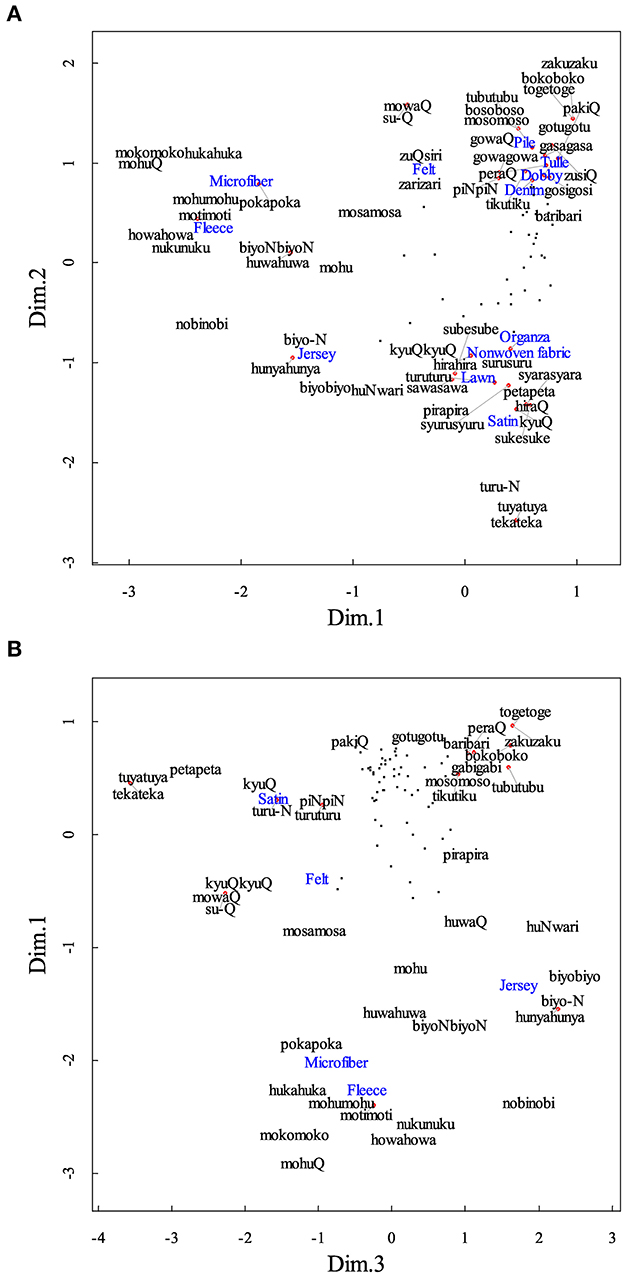
Figure 3. The original biplot obtained by correspondence analysis on the contingency table of fabrics × onomatopoeic words. Plots (A, B) are projections to the planes of dimensions 1–2 and 3–1, respectively. The onomatopoeias with absolute coordinates ≤ 0.8 on either the horizontal or vertical axis were shown by dots.
Consequently, the axes of the biplot were rotated using the sparse coding technique; the configurations were rotated to minimize the sum of the absolute coordinates for the fabrics and onomatopoeic words, which is an index of sparseness wherein lower values indicate increased sparser representation. Furthermore, this rotation was used for the biplot obtained using correspondence analysis in the studies of visual material perception (Hanada, 2016) and food texture (Hanada, 2020). Thus, the perceptual dimensions of visual material perception and food texture were successfully extracted using this technique.
The rotated biplot is presented in Figure 4, which only presents the items with absolute coordinates larger than either 0.8 on the horizontal or vertical axis on each plot for visibility. Meanwhile, Table 4 presents the coefficients between the coordinates of the corresponding fabrics in the rotated biplot obtained from the correspondence analysis and the mean scale scores for the fabrics. The correlation coefficients between the coordinates of the configurations of the fabrics and onomatopoeic words in the rotated biplot were very low (< 0.2), which means that the dimensions of the rotated biplot were almost unrelated to each other.
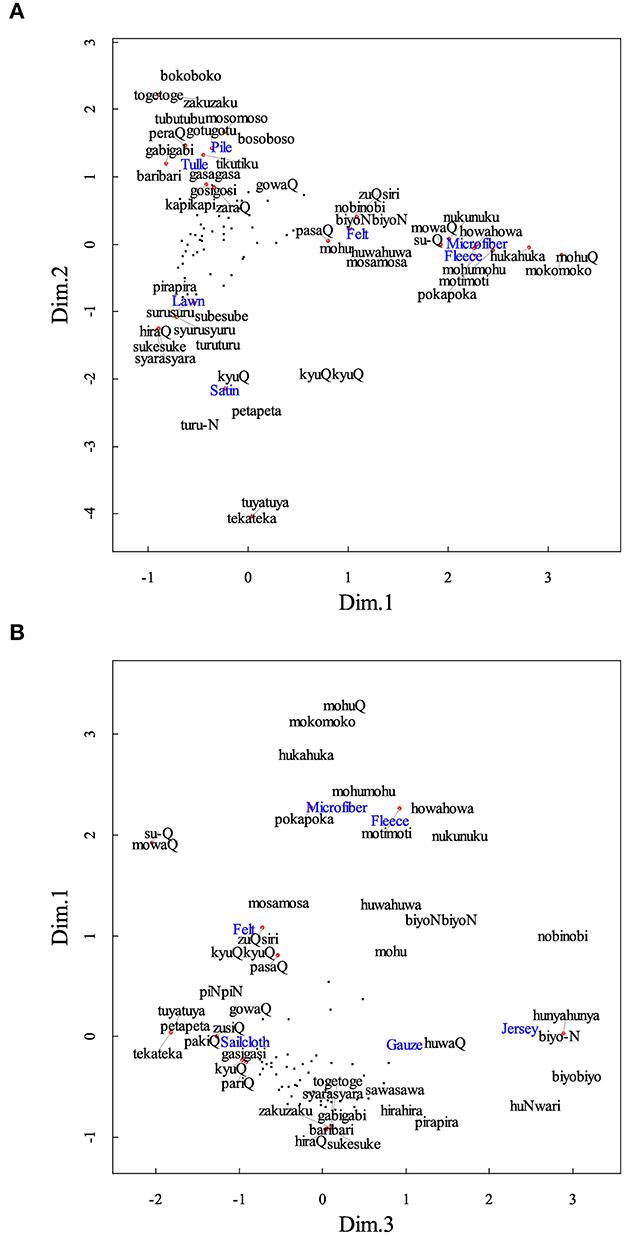
Figure 4. The biplot rotated by the technique of sparse coding. Plots (A, B) are projections to the planes of dimensions 1–2 and 3–1, respectively. The onomatopoeias with absolute coordinates ≤ 0.8 on either the horizontal or vertical axis were shown by dots.
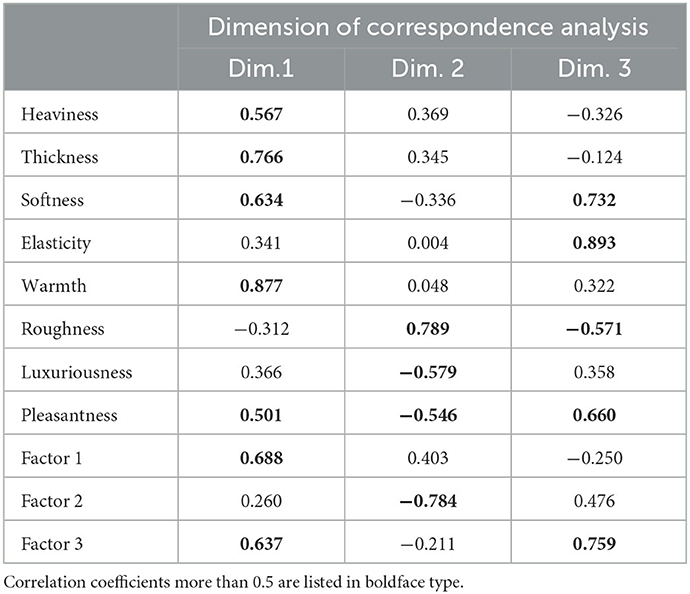
Table 4. Correlation coefficients between the coordinates of the corresponding fabrics in the biplot obtained by correspondence analysis, and the mean scale and factor scores for the fabrics.
Figure 4A presents the projection to the first and second dimensions of the configuration of the biplot. The onomatopoeic words mohuQ, mokomoko, hukahuka, mohumohu, howahowa, pokapoka, motimoti, and nukunuku, and fabrics Microfiber, Fleece, and Felt have a moderately large coordinate value on the first dimension. Onomatopoeic words nukunuku and pokapoka denote warmth, and mohuQ, mokomoko, hukahuka, and mohumohu represent softness for thick fabrics. The ratings of the above fabrics on the scales of thickness, softness, and warmth were high except for the perceived softness of Felt (Table 1). Moreover, the fabrics' coordinates were strongly correlated with the mean ratings of warmth, thickness, and softness. Thus, dimension 1 reflects warmness/fullness/softness, or the warm and soft feeling of the thick fabrics, and is seemingly similar to the concept of Fukurami, which has been used by Japanese experts of fabric hand feel. The positive side of the second dimension comprises onomatopoeic words including bokoboko, togetoge, zakuzaku, tubutubu, mosomoso, and bosoboso, and fabrics Pile and Tulle. Onomatopoeic words bokoboko and tubutubu indicate bumping surface, togetoge often represent spikiness, and mosomoso means the somewhat rigid and dry feeling. The onomatopoeic word bosoboso usually means murmuring, but it seems that some participants used it to describe the same feeling of mosomoso. The mean ratings of roughness for fabrics Tulle and Pile were high. Thus, this positive side indicates roughness. The negative side of the second dimension comprises kyuQ, petapeta, turu-N, tekateka, tuyatuya, and, turuturu, and fabrics lawn and satin. The onomatopoeic words turu-N and turuturu indicate smooth surfaces. Furthermore, onomatopoeic words tekateka, and tuyatuya generally indicate glossiness, which cannot be perceived directly from touching; the participants did not see the stimulus fabrics, and hence, glossiness would be inferred by the smooth tactile feeling. The positive side of this dimension represents smoothness. Thus, the second dimension should represent roughness-smoothness.
Figure 4B demonstrates the third and first dimensions of the configuration. The onomatopoeic words biyobiyo, hunyahunya, nobinobi, biyo-N, and huNwari, and fabrics Jersey and Gauze have large coordinates on this dimension. The onomatopoeic words biyobiyo, hunyahunya, nobinobi, and biyo-N generally describe elastic materials, and huNwari denotes the soft and swelling feeling of fabrics. Furthermore, the evaluation performed found that Jersey and Gauze were soft and Jersey was very elastic. The coordinates of the fabrics were strongly correlated with the mean ratings of elasticity and softness. Thus, the third dimension represents elasticity/softness.
The correlation coefficients between the mean factor scores and the coordinates of the fabrics in the biplot are presented in the lower part of Table 4. The mean factor scores of factor 2, named as the roughness factor, correlated highly with only the coordinates on the second biplot dimension highly related to roughness-smoothness. Thus, the second biplot dimension corresponds relatively well to the second factor, though the first and third factors are also moderately correlated to the second dimension of the biplot. However, the coordinates on the first biplot dimension that would represent warmness, fullness, and softness were strongly correlated with the scores of factor 1 (thickness/heaviness factor) and factor 3 (softness factor). Additionally, the coordinates on the third biplot dimension that should represent elasticity/softness were not only strongly correlated with the scores of factor 3 (softness factor), but also moderately correlated with those of factor 1 (thickness/heaviness). Thus, the dimensions derived by the correspondence analysis presented in Figure 4 do not exhibit one-to-one correspondence to the factors.
3.3. Linear regression of luxuriousness and pleasantness to fabrics' characteristics
A multiple regression analysis was performed to examine the relationship between the characteristics of fabrics and their luxuriousness and pleasantness. The ratings of luxuriousness or pleasantness for each fabric of each participant were regressed to the ratings of heaviness, thickness, softness, elasticity, warmth, and roughness for each fabric of each participant. The results for luxuriousness and pleasantness are presented in Tables 5, 6, respectively. Consequently, the partial regression coefficients of heaviness, elasticity, and roughness for the regression to luxuriousness were significant. Furthermore, the heavier, more elastic, and smoother fabrics felt more luxurious. For the regression to pleasantness, the partial regression coefficients of softness, elasticity, warmth, and roughness for the regression to luxuriousness were significant, and the softer, more elastic, warmer, and smoother fabrics felt more pleasant. We found that the absolute partial coefficient and t statistic of roughness were the largest for luxuriousness and pleasantness, which indicates that roughness-smoothness most significantly affected the ratings of luxuriousness and pleasantness. Further, elasticity considerably affected both luxuriousness and pleasantness. However, heaviness affected luxuriousness more than pleasantness, while softness and warmth exhibited a larger effect on pleasantness than on luxuriousness. While the ratings of luxuriousness and pleasantness were strongly correlated (r = 0.69), the different patterns of the regressions suggest that luxuriousness and pleasantness represent different concepts. Particularly, the coefficient of determination (R2) was higher for pleasantness (R2= 0.535) than for luxuriousness (R2= 0.323) (R2 indicates the proportion of the variance in the dependent variable explained by the linear regression model, and a measure of goodness of fit). Thus, pleasantness was determined more by the regressors (i.e., the properties of thickness, softness, elasticity, warmth, and roughness) than luxuriousness, and factors other than those regressors affected the luxuriousness perception more than pleasantness perception.
3.4. Analysis of phonemes related to luxuriousness and pleasantness
To examine how luxuriousness and pleasantness are related to the phonemes of Japanese onomatopoeic words, this study investigated the probability of each consonant and vowel in the first syllable appearing for given luxuriousness and pleasantness. Multinomial logistic regression was performed (Borooah, 2002), wherein the probabilities of the consonants and vowels of the first syllables in an onomatopoeic word were regressed to luxuriousness and pleasantness. The probability of the phonemic element j (e.g., consonant /s/ in the first syllable) appearing was modeled as follows:
where X is the rating of luxuriousness and pleasantness (1–7), and M is the number of the phonemic elements at issue. Multinomial logistic regression was conducted for the vowel and consonant in the first syllable separately. These independent analyses for the two elements would be supported because the vowel and consonant seem to contribute to the sound symbolism of Japanese onomatopoeic words independently (Hamano, 1986). This study only analyzed the phonemes in the first syllable as this is considered to have strong sound-symbolic associations in Japanese onomatopoeic words (Hamano, 1986). Furthermore, other studies on sound symbolism exploring Japanese onomatopoeic words also focused on the first syllable (Watanabe et al., 2011; Sakamoto and Watanabe, 2018). The parameters β0j, β1j (1, ⋯ , M) were estimated using the maximum likelihood method. The consonants /d/, /y/, /r/, and /w/ were excluded from this analysis even though some onomatopoeic words express these consonants in the first syllable in Japanese. However, these onomatopoeic words did not appear in any of the responses. The probability of phonemic elements as a function of luxuriousness and pleasantness is presented in Figures 5, 6, respectively. The tendencies for luxuriousness and pleasantness were considerably similar. The probability of consonants /s/, /t/, /h/, and /m/ increased, whereas that of /k/, /g/, /z/, and /p/ decreased with the increase in luxuriousness (Figure 5A). In terms of the vowel in the first syllable, the probability of /u/ increased whereas /a/ decreased with the increase in luxuriousness (Figure 5B). Similarly, the probability of consonants /s/, /h/, and /m/ tended to increase, whereas /k/, /g/, /z/, and /p/ tended to decrease with the increase of pleasantness (Figure 6A). Moreover, the probability of /u/ increased whereas /a/ decreased with increasing pleasantness (Figure 6B).
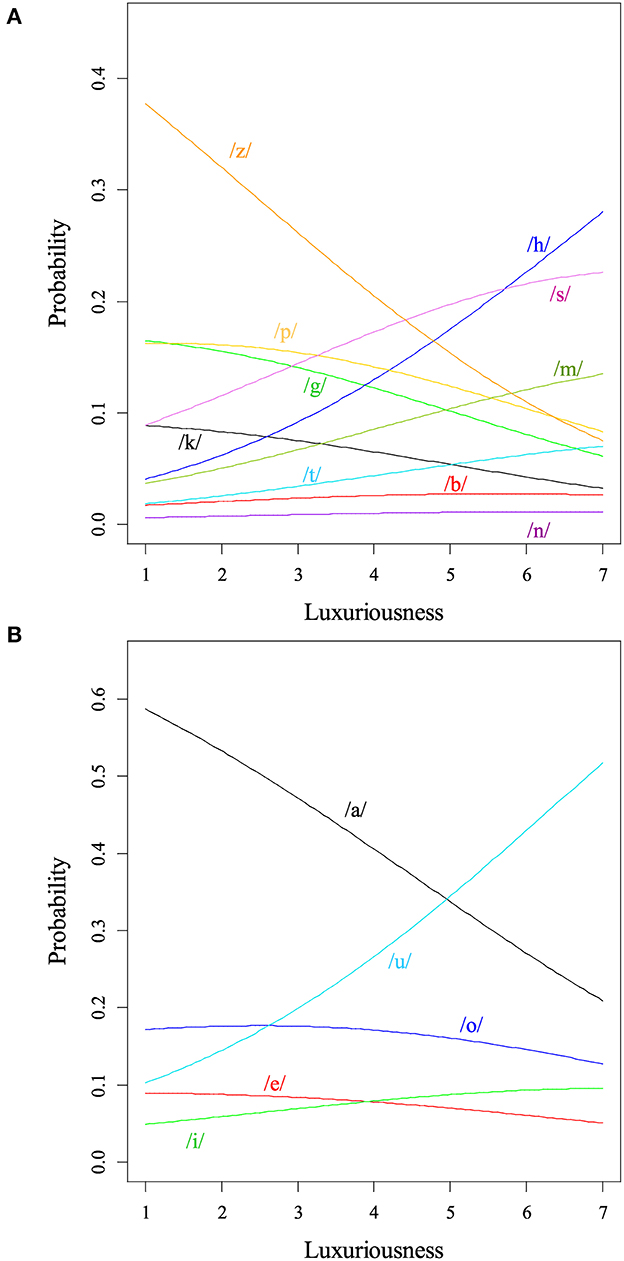
Figure 5. Results of the multinomial logistic regression, in which probabilities of the consonants and vowels of the first syllables for an onomatopoeic word were regressed to luxuriousness. (A) Modeled probabilities of the first consonants as a function of luxuriousness. (B) Modeled probabilities of the first vowels as a function of luxuriousness.
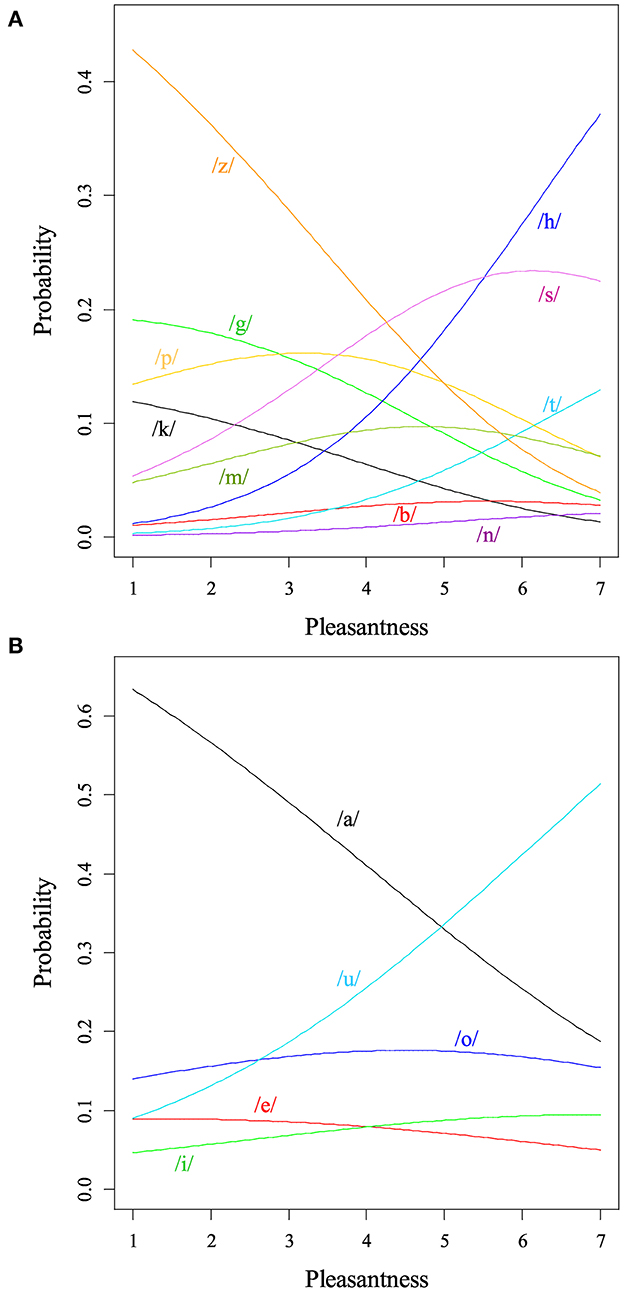
Figure 6. Results of the multinomial logistic regression, in which probabilities of the consonants and vowels of the first syllables for an onomatopoeic word were regressed to pleasantness. (A) Modeled probabilities of the first consonants as a function of pleasantness. (B) Modeled probabilities of the first vowels as a function of pleasantness.
The average marginal effect (AME) of luxuriousness and pleasantness on the probability of the consonants and vowels is illustrated in Figures 7, 8, respectively. AME represents the average of predicted changes in the dependent variable. In this context, this refers to the probability of a phoneme appearing for one unit change in a specific independent variable (X), while other variables remain constant (Borooah, 2002). In a sense, the AME is the mean slope across luxuriousness or pleasantness for a specific curve in Figures 5, 6. We calculated a 95% interval using the bootstrap method (Efron and Tibshirani, 1994) with 2,000 bootstrap samples. The AMEs of luxuriousness on the probability of consonants /s/, /t/, and /h/ were significantly larger than zero. By contrast, the AMEs of the probability of consonants /k/, /g/, /z/, and /p/ are significantly smaller than zero. Regarding the vowel, the AME of luxuriousness on the probability of /u/ was significantly positive, whereas the probability of /a/ was significantly negative. The pattern of the statistical significance for pleasantness was consistent with that for luxuriousness, except for the non-significant AME for consonant /t/.
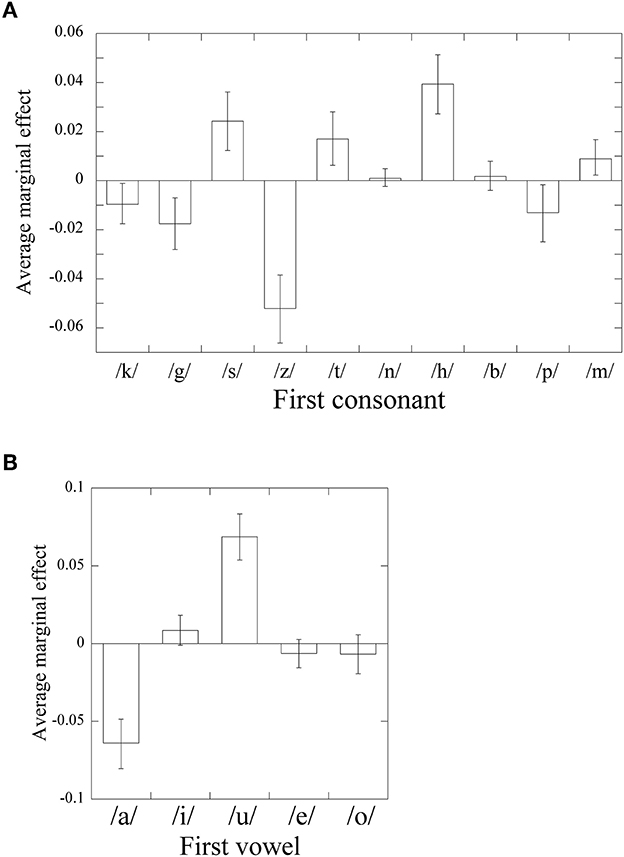
Figure 7. The average marginal effect (AME) of luxuriousness on the probability of the consonants (A) and vowels (B) in the first syllable. The error bars stand for the 95% confident intervals.
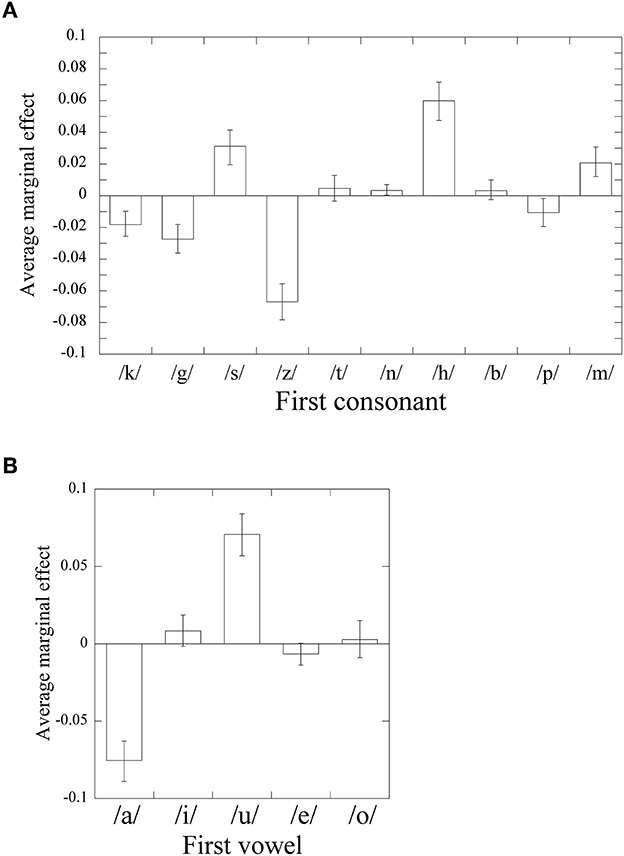
Figure 8. The average marginal effect (AME) of pleasantness on the probability of the consonants (A) and vowels (B) in the first syllable. The error bars stand for the 95% confident intervals.
4. Discussion
This study examined perceptual dimensions in fabrics' tactile perception. The participants were asked to touch, stretch, and curl 23 fabrics, and report onomatopoeic (mimetic) words suitable for describing the touch feeling for each fabric. The participants' responses were collated into a contingency table of fabrics by onomatopoeic words. The participants also rated the fabrics' touch feeling using the SD scales.
This study extracted the tactile dimensions of the touch of fabrics in two ways. Factor analysis of the ratings of fabrics with the varimax rotation revealed the three dimensions of thickness/heaviness, roughness, and softness. The dimensions of roughness and softness are included in the psychophysical dimensions of tactile perception proposed by Okamoto et al. (2013). The roughness and softness factors comprise basic tactile dimensions. The thickness/heaviness dimension is not included in the basic tactile dimensions of Okamoto et al. (2013) and would be specific to fabric perception. The obtained three factors would represent perceptual correlates of physical properties of fabrics (friction, compression, thickness, and weight). The lack of the thickness/heaviness dimensions would be because the tactile dimensions of Okamoto et al. (2013) are seemingly meant for psychological dimensions of textures in touching or, more appropriately, stroking and pushing. However, determining thickness and weight merely by stroking and pushing texture is difficult. Thus, the current results suggest that thickness and weight are important for fabric tactile perception. By contrast, correspondence analysis applied on the onomatopoeic words × fabrics contingency table with the rotation of sparse coding reveals the dimensions of warmness/fullness/softness, roughness-smoothness, and elasticity/softness. The second factor (roughness) of factor analysis is roughly consistent with the second dimension (roughness-smoothness) of correspondence analysis. However, the dimensions of correspondence analysis did not align with the other factors. The factors derived by factor analysis would represent basic tactile dimensions of fabrics based on mechanical and surface properties, whereas the dimensions of correspondence analysis apparently represent more nuanced tactile feelings of fabrics than the factors. These suggest that onomatopoeic words should express feelings that cannot be described by a single tactile property but should be represented by the combinations of multiple tactile properties. Japanese onomatopoeic words may be apt to express subtle feelings regarding fabrics, whereas normal adjective words are suitable to describe fabrics' basic physical tactile properties.
Several studies have extracted fabrics' perceptual dimensions. For example, Fernandes and Albuquerque (2008) obtained one perceptual dimension using multi-dimensional scaling to similarity data for wool fabrics. This dimension was extracted from the data on wool fabrics. Our results of the SD data and responses of onomatopoeic words suggest that more dimensions are required to describe the feeling of general fabrics. Soufflet et al. (2004) derived three perceptual dimensions of fabric hand feel, soft-harsh, thin-thick, and supple-stiff. The dimensions of the fabric hand feel may correspond to the dimensions that this study derived from the SD ratings if their soft/harsh dimension dominantly represents smoothness-roughness and their supple-stiff dimension expresses the softness dimension of this study. Lee and Sato (2001) extracted three factors: voluminous and warm feeling, glossy feeling, and fine feeling. Their first factor was related to softness, warmness, and volume as well as elegance and high quality, and similar to the first dimension of the biplot in Figure 4. Their second factor (glossy feeling) was visual; no perceptual dimension in our results directly corresponds to it, though the second dimension of the biplot is related to onomatopoeic words of glossiness, such as tekateka, and tuyatuya. Their third factor was related to fineness, smoothness, and high density, and similar to the second factor obtained from the SD ratings and the second dimension of the rotated biplot in the present study. Thus, the visual dimensions of fabrics are similar to some tactile dimensions of fabrics obtained from onomatopoeic words and SD ratings, though some differences exist between fabrics' visual and tactile dimensions.
Correspondence analysis has been used in some studies of cross-modal correspondence, but compared with numerous such studies, few studies have used correspondence analysis. This study revealed that correspondence analysis can help visualize the tactile space of Japanese onomatopoeic words about fabrics compactly by summarizing the contingency table into spatial representation. Combined with the rotation by sparse coding, the dimensional structure of tactile space of Japanese onomatopoeic representations of fabric hand feel can be revealed. Thus, correspondence analysis is a powerful tool for studying cross-modal correspondence.
The results also showed that sound symbolisms in Japanese onomatopoeic words in the touch feeling of fabrics. For example, the first dimension in the biplot shown in Figure 4A, represents the warm and soft feeling of the thick fabrics and is strongly related to the onomatopoeic words that start the consonants /m/ (mohu, mokomoko, mohumohu, and motimoti) and /h/ (hukahuka and howahowa). It was suggested that the first syllables /mo/ and /hu/ represent warmness, and the /hu/ sound symbolically expresses softness and elasticity (Sakamoto and Watanabe, 2018). The positive side of the second dimension in Figure 4A would represent roughness and was strongly related to onomatopoeic words that start the consonants /b/ (bokoboko and bosoboso) and /g/ (gotugotu, and gasagasa, and gabigabi). Overall, this side of the dimension was related to the voiced first consonants, though it was also related to some onomatopoeic words that have the voiceless first consonant /t/ (togetoge, and tubutubu). Notably, since Japanese has ordinary words toge, which means thorn, and tubu, which means grain/particle, these words may not be considered pure mimetics. By contrast, the negative side of the second dimension in Figure 4A indicates smoothness, which was also related to the onomatopoeic words that have the first consonants /t/ (tuyatuya and tekateka) and /s/ (syarasyara, subesube, and surusuru). Consonant /t/ seemingly represents glossiness inferred by the smooth feeling of fabrics, while consonant /s/ is said to represent smoothness (Hamano, 1986; Sakamoto and Watanabe, 2018). The phoneme “s” could also imply smoothness in English as in “slip,” “slime,” “slop,” and “slid.” The third dimension in Figure 4B, which would represent elasticity and softness, is associated with the onomatopoeic words with the first syllables of /bi/ and /hu/. The syllable /hu/, which could be audible as /fu/ to English speakers, symbolizes softness while the onomatopoeic words associated with the first dimension, and /bi/ sound would symbolically express elasticity. Thus, the sound symbolism in Japanese onomatopoeic words can be read out from the biplot in Figure 4. Hence, this study provided useful information on Japanese sound symbolism in tactile perception.
Further, this study examined pleasantness and luxuriousness in touch for fabrics. The fabric characteristics for pleasantness and luxuriousness were similar, and the smoothness and elasticity of fabrics contributed to both pleasantness and luxuriousness. However, some differences existed; heaviness affected luxuriousness more, and warmth had more effects on pleasantness. The similarity and difference suggest that luxuriousness is partly derived from pleasantness, but pleasantness does not fully explain luxuriousness. Notably, luxuriousness was not so much related to actual monetary values. While Jersey (No. 1) is not an expensive fabric, it exhibited the highest rating of luxuriousness. Moreover, Tulle (No. 23), which reports the lowest luxuriousness score as presented in Table 1, is not inexpensive compared with other fabrics.
Further, this study examined the phonemes in the first syllable related to the onomatopoeic words that express luxuriousness and pleasantness. Consequently, we found that the phonemes related to luxuriousness were highly similar to those associated with pleasantness. While consonants /s/, /h/, and /m/ and vowel /u/ were related to luxuriousness and pleasantness. Furthermore, consonants /k/, /g/, /z/, and /p/ and vowel /a/ were associated with cheapness and unpleasantness. One possibility is that these phonemes symbolize pleasantness and luxuriousness of themselves. The alternative explanation is that these phonemes sound-symbolically represent smoothness and elasticity, which lead to luxuriousness and pleasantness as presented in the regression analyses in Tables 5, 6. Consonants /s/, /g/, and /z/ seem to symbolize smoothness and roughness, respectively, while /h/ and /m/ implicates elasticity. These phonemes should be associated with luxuriousness and pleasantness because they symbolize the characteristics that invoke them. The other phonemes, such as /k/ and /p/, seemingly have no relation to the fabric properties related to luxuriousness and pleasantness. Hence, /k/ and /p/ might directly symbolize luxuriousness and pleasantness, though it is likely that they symbolized perceptual characteristics invoking luxuriousness and pleasantness other than those examined in this study. Watanabe et al. (2011) examined relationships between phonemes of onomatopoeic words and pleasantness-unpleasantness in touch with various objects (not limited to fabrics). They found that pleasantness is related to consonants /h/ /s/ and /m/ and vowel /u/, while unpleasantness was associated with consonants /z/ /sy/ /g/ and /b/ and vowel /i/ and /e/ in the first syllable of onomatopoeic words. The phonemes related to pleasantness are similar to the phonemes in this study. By contrast, the phonemes related to unpleasantness are different; /sy/, /b/, /i/ and /e/ expressed in the study by Watanabe et al. (2011), and /k/, /p/, and /a/ for this study, though /z/ and /g/ are associated with unpleasantness for both of the studies. The reason for this discrepancy could be that different objects are used as stimuli; while this study focused on fabrics, Watanabe et al. (2011) examined the tactile perception of various objects. Further, this discrepancy suggests that the phonemes related to unpleasantness found herein do not symbolize their own unpleasantness but rather the fabric characteristics related to unpleasantness; if there are phonemes that symbolize unpleasantness in touch, they should appear across different studies.
This study had several limitations. First, all the participants were Japanese university students; whether the results can be generalized to children, older Japanese, and fabric professionals is unknown. The Japanese evaluation experts on fabric hand feel used particular terms—such as Koshi (stiffness), Numeri (Smoothness), and Fukurami (fullness and softness)—that have been rarely used by non-experts when judging fabrics. Thus, the experts might have used different onomatopoeic words to describe the touch feel of fabrics. Second, although various fabrics with different hands were used in this study, all fabrics may not have been covered. Thus, tactile dimensions of fabrics expressed by Japanese onomatopoeia—other than the dimensions obtained in this study—could have been found. Third, this study examined tactile, but not visual, or visual-tactile judgment of fabrics despite several reports indicating the similarity between visual and tactile texture judgments (e.g., Lederman et al., 1986; Baumgartner et al., 2013). However, some studies have reported differences between tactile and visual-tactile judgment (e.g., Burns et al., 1995). Moreover, onomatopoeic words for expressing glossy appearance are related to the second dimension in the biplot presented in Figure 4, which suggests that visual appearance is important for fabric judgment. Additionally, the luxuriousness of pearl and gold leaves was found to be related to different usages of visual and tactile onomatopoeic words (Kwon et al., 2017). Fourth, we did not examine the relationship between onomatopoeic words that describe fabric hand feel, and the mechanical and surface properties of the fabrics. The mechanical and surface properties of fabrics evoke tactile sensations, which would then elicit onomatopoeic descriptions. This study focused on the latter process from tactile sensations, which can be measured by the SD ratings, to production of onomatopoeic expressions. Thus, the subjective evaluations by the SD scales and those by onomatopoeic expressions were examined in this study. In future, it would be required to examine the relationship between physical properties of fabrics and onomatopoeic words that describe the hand feel of the fabrics. It would also be interesting to develop a method to predict onomatopoeic words to describe fabric hand feel from the mechanical and surface properties using advanced machine-learning techniques such as fuzzy logic, fuzzy neural network, and deep neural network. Thus, further studies are required to clarify and solve these issues.
5. Conclusion
This study examined fabrics' tactile dimensions in two ways, specifically using Japanese onomatopoeic words expressing the tactile feelings of fabrics, and using the ratings on the scales of adjective pairs. The tactile dimensions derived by correspondence analysis augmented by sparse coding are warmness/fullness/softness, roughness–smoothness, and elasticity/softness, whereas the dimensions by factor analysis to the ratings on the adjective-pair scales with the varimax rotation are thickness/heaviness, roughness, and softness, which differ from those given by onomatopoeic words. Onomatopoeic words seemingly describe subtle and complex tactile feelings of fabrics generated by a combination of multiple basic physical characteristics. This view is consistent with the reports that single onomatopoeic words can be used to calculate multidimensional ratings of tactile sensations (Doizaki et al., 2017), and ratings of personality traits about individuals (Sakamoto et al., 2021); in the case of personality traits, more than half of the variations of the personality ratings can be explained by single onomatopoeic words. Onomatopoeic words would have the potential to express subtle meanings that need multiple adjectives to express the same meaning. Indo-European languages did not generally have word classes corresponding to onomatopoeic words that express manners and states, but Korean, Basque, sub-Saharan African languages, and some languages in south-east Asia contain many onomatopoeic words (idiophones) (Dingemanse, 2018). Conducting similar experiments using those languages and comparing the results with those obtained in this study would be interesting. Correspondence analysis with sparse coding reveals the dimensional structure of the fabric-onomatopoeia correspondences. This technique may be helpful in studying other cross-modal correspondences.
Data availability statement
The raw data supporting the conclusions of this article will be made available by the authors, without undue reservation.
Ethics statement
The studies involving human participants were reviewed and approved by the Ethics Committee of Future University Hakodate. The patients/participants provided their written informed consent to participate in this study.
Author contributions
The author confirms being the sole contributor of this work and has approved it for publication.
Funding
This work was partially supported by JSPS KAKENHI Grant Number 17K04496.
Acknowledgments
I would like to thank the members of my laboratory who assisted in the preparation of the experimental materials and data acquisition.
Conflict of interest
The author declares that the research was conducted in the absence of any commercial or financial relationships that could be construed as a potential conflict of interest.
Publisher's note
All claims expressed in this article are solely those of the authors and do not necessarily represent those of their affiliated organizations, or those of the publisher, the editors and the reviewers. Any product that may be evaluated in this article, or claim that may be made by its manufacturer, is not guaranteed or endorsed by the publisher.
Supplementary material
The Supplementary Material for this article can be found online at: https://www.frontiersin.org/articles/10.3389/flang.2023.1075055/full#supplementary-material
References
Akita, K. (2009). A Grammar of Sound-Symbolic Words in Japanese: Theoretical Approaches to Iconic and Lexical Properties of Mimetics. Kobe Japan: Kobe University dissertation.
American Association of Textile Chemists and Colorists (AATCC) (2006). “Evaluation procedure 5: Guidelines for the subjective evaluation of fabric hand,” in AATCC Technical Manual, 684–685.
Asano, M., Imai, M., Kita, S., Kitajo, K., Okada, H., Thierry, G. (2015). Sound symbolism scaffolds language development in preverbal infants. Cortex 63, 196–205. doi: 10.1016/j.cortex.2014.08.025
Baumgartner, E., Wiebel, C. B., Gegenfurtner, K. R. (2013). Visual and haptic representations of material properties. Multi. Res. 26, 429–455. doi: 10.1163/22134808-00002429
Behery, H. (2005). Effect of Mechanical and Physical Properties on Fabric Hand. Cambridge England: Woodhead Publishing.
Bergmann Tiest, W. M., Kappers, A. M. (2007). Haptic and visual perception of roughness. Acta psychologica 124, 177–189. doi: 10.1016/j.actpsy.2006.03.002
Burns, L. D., Chandler, J., Brown, D. M., Cameron, B., Dallas, M. J., Kaiser, S. B. (1995). Sensory interaction and descriptions of fabric hand. Percept. Motor Skills 81, 120–122. doi: 10.2466/pms.1995.81.1.120
Choudhary, A. K., Goel, A. (2013). Effect of some fabric and sewing conditions on apparel seam characteristics. J. Textiles 2013, 1–7. doi: 10.1155/2013/157034
Clausen, S. E. (1998). Applied Correspondence Analysis: An Introduction. Thousand Oaks, CA: Sage Publication.
Dingemanse, M. (2018). Redrawing the margins of language: lessons from research on ideophones. Glossa J. Gen. Linguist. 3, 4. doi: 10.5334/gjgl.444
Doizaki, R., Watanabe, J., Sakamoto, M. (2017). Automatic estimation of multidimensional ratings from a single sound-symbolic word and word-based visualization of tactile perceptual space. IEEE Trans. Haptics 10, 173–182. doi: 10.1109/TOH.2016.2615923
Fernandes, A., Albuquerque, P. B. (2008). “Tactile perceptual dimensions: a study with light-weight wool fabrics,” in International Conference on Human Haptic Sensing and Touch Enabled Computer Applications. Springer, Berlin: Heidelberg, 337–342.
Gescheider, G. A., Bolanowski, S. J., Greenfield, T. C., Brunette, K. E. (2005). Perception of the tactile texture of raised-dot patterns: a multidimensional analysis. Somatosen. Motor Res. 22, 127–140. doi: 10.1080/08990220500262018
Guest, S., Dessirier, J. M., Mehrabyan, A., McGlone, F., Essick, G., Gescheider, G., et al. (2011). The development and validation of sensory and emotional scales of touch perception. Atten. Percept. Psychophys. 73, 531–550. doi: 10.3758/s13414-010-0037-y
Hamano, S. (1986). The Sound-Symbolic System of Japanese. Gainesville: University of Florida dissertation.
Hanada, M. (2016). Using Japanese onomatopoeias to explore perceptual dimensions in visual material perception. Perception 45, 568–587. doi: 10.1177/0301006616629028
Hanada, M. (2020). Food-texture dimensions expressed by Japanese onomatopoeic words. J. Text. Stud. 51, 398–411. doi: 10.1111/jtxs.12499
Hollins, M., Faldowski, R., Rao, S., Young, F. (1993). Perceptual dimensions of tactile surface texture: a multidimensional scaling analysis. Percept. Psychophys. 54, 697–705. doi: 10.3758/BF03211795
Hyvärinen, A., Karhunen, J., Oja, E. (2001). Independent Component Analysis. New York, NY: Wiley-Interscience.
Imai, M., Kita, S., Nagumo, M., Okada, H. (2008). Sound symbolism facilitates early verb learning. Cognition 109, 54–65. doi: 10.1016/j.cognition.2008.07.015
Kanai, H., Morishima, M., Nasu, K., Nishimatsu, T., Shibata, K., Matsuoka, T. (2011). Identification of principal factors of fabric aesthetics by the evaluation from experts on textiles and from untrained consumers. Text. Res. J. 81, 1216–1225. doi: 10.1177/0040517511399960
Kandzhikova, G. D., Germanova-Krasteva, D. S. (2016). Subjective evaluation of terry fabrics handle. J. Text. Inst. 107, 355–363. doi: 10.1080/00405000.2015.1034927
Kawabata, S. (1980). The Standardization and Analysis of Fabric Hand. 2nd ed. Textile Osaka: Machinery Society of Japan.
Kawabata, S., Niwa, M. (1989). Fabric performance in clothing and clothing manufacture. J. Text. Inst. 80, 19–50. doi: 10.1080/00405008908659184
Kwon, J., Yoshino, J., Kosahara, M., Nakauchi, S., Sakamoto, M. (2017). Relation between naturalness and luxuriousness through onomatopoeia expressing texture. Jap. J. Psych. Sci. 36, 40–49. doi: 10.14947/psychono.36.7
Lederman, S. J., Thorne, G., Jones, B. (1986). Perception of texture by vision and touch: multidimensionality and intersensory integration. J. Exp. Psychol. Hum. Percept. Perform. 12, 169. doi: 10.1037/0096-1523.12.2.169
Lee, W., Sato, M. (2001). Visual perception of texture of textiles. Color Res. Appl. 26, 469–477. doi: 10.1002/col.1067
Nenadic, O., Greenacre, M. (2007). Correspondence analysis in R, with two- and three-dimensional graphics: The ca package. J. Stat. Soft. 20, 1–13. doi: 10.18637/jss.v020.i03
Okamoto, S., Nagano, H., Yamada, Y. (2013). Psychophysical dimensions of tactile perception of textures. IEEE Trans. Haptics 6, 81–93. doi: 10.1109/TOH.2012.32
Özdemir, H. (2017). Thermal comfort properties of clothing fabrics woven with polyester/cotton blend yarns. Autex Res. J. 17, 135–141. doi: 10.1515/aut-2016-0012
Park, S. W., Hwang, Y. G., Kang, B. C., Yeo, S. W. (2000). Applying fuzzy logic and neural networks to total hand evaluation of knitted fabrics. Text. Res. J. 70, 675–681. doi: 10.1177/004051750007000804
Picard, D., Dacremont, C., Valentin, D., Giboreau, A. (2003). Perceptual dimensions of tactile textures. Acta Psychol. 114, 165–184. doi: 10.1016/j.actpsy.2003.08.001
Sakamoto, M., Watanabe, J. (2017). Exploring tactile perceptual dimensions using materials associated with sensory vocabulary. Front. Psychol. 8, 569. doi: 10.3389/fpsyg.2017.00569
Sakamoto, M., Watanabe, J. (2018). Bouba/Kiki in touch: associations between tactile perceptual qualities and Japanese phonemes. Front. Psychol. 9, 295. doi: 10.3389/fpsyg.2018.00295
Sakamoto, M., Watanabe, J., Yamagata, K. (2021). Automatic estimation of multidimensional personality from a single sound-symbolic word. Front. Psychol. 12, 595986. doi: 10.3389/fpsyg.2021.595986
Slater, K. (1997). Subjective textile testing. J. Text. Inst. 88, 79–91. doi: 10.1080/00405009708658532
Soufflet, I., Calonnier, M., Dacremont, C. (2004). A comparison between industrial experts' and novices' haptic perceptual organization: a tool to identify descriptors of the handle of fabrics. Food Qual. Prefere. 15, 689–699. doi: 10.1016/j.foodqual.2004.03.005
Stone, J. V. (2004). Independent Component Analysis: A Tutorial Introduction. Cambridge, MA: MIT Press.
Sülar, V., Okur, A. (2007). Sensory evaluation methods for tactile properties of fabrics. J. Sens. Stud. 22, 1–16. doi: 10.1111/j.1745-459X.2007.00090.x
Sun, D. (2018). “Fabric handle as a concept for high-performance apparel,” in High-Performance Apparel (Cambridge: Woodhead Publishing), 307–323.
Tadesse, M. G., Harpa, R., Chen, Y., Wang, L., Nierstrasz, V., Loghin, C. (2019). Assessing the comfort of functional fabrics for smart clothing using subjective evaluation. J. Indust. Text. 48, 1310–1326. doi: 10.1177/1528083718764906
Valatkiene, L., Strazdiene, E. (2006). Accuracy and reliability of fabric's hand subjective evaluation. Mater. Sci. 12, 253–257.
Watanabe, J., Kano, A., Shimizu, Y., Sakamoto, M. (2011). Relationship between judgments of comfort and phonemes of onomatopoeias in touch. Trans. Virtual Real. Soc. Japan 16, 367–370. doi: 10.18974/tvrsj.16.3_367
Watanabe, J., Sakamoto, M. (2012). “Comparison between onomatopoeias and adjectives for evaluating tactile sensations,” in Proceedings of the 6th International Conference of Soft Computing and Intelligent Systems and the 13th International Symposium on Advanced Intelligent Systems (SCIS-ISIS 2012) Kobe, 2346–2348.
Wong, A. S. W., Li, Y., Yeung, P. K. W., Lee, P. W. H. (2003). Neural network predictions of human psychological perceptions of clothing sensory comfort. Text. Res. J. 73, 31–37. doi: 10.1177/004051750307300106
Yoshida, M. (1968a). Dimensions of tactual impressions (1). Jap. Psychol. Res. 10, 123–137. doi: 10.4992/psycholres1954.10.123
Yoshida, M. (1968b). Dimensions of tactual impressions (2). Jap. Psychol. Res. 10, 157–173. doi: 10.4992/psycholres1954.10.157
Yoshioka, T., Bensmaia, S. J., Craig, J. C., Hsiao, S. S. (2007). Texture perception through direct and indirect touch: an analysis of perceptual space for tactile textures in two modes of exploration. Somatosens. Motor Res. 24, 53–70. doi: 10.1080/08990220701318163
Yu, Y., Hui, C. L., Choi, T. M., Au, R. (2010). Intelligent fabric hand prediction system with fuzzy neural network. IEEE Trans. Syst. Man Cybern. Pt. C Appl. Rev. 40, 619–629. doi: 10.1109/TSMCC.2010.2045121
Keywords: fabric, cloth, Japanese onomatopoeic words, tactile dimensions, sound symbolism, mimetics
Citation: Hanada M (2023) Tactile dimensions of fabrics expressed by Japanese onomatopoeic words and phonemic features related to fabric luxuriousness and pleasantness. Front. Lang. Sci. 2:1075055. doi: 10.3389/flang.2023.1075055
Received: 02 November 2022; Accepted: 24 January 2023;
Published: 10 February 2023.
Edited by:
Desalegn Atalie, Bahir Dar University, EthiopiaReviewed by:
Melkie Getnet Tadesse, Hochschule Albstadt-Sigmaringen, GermanySevgi Çakmak, Bursa Uludag University, Türkiye
Copyright © 2023 Hanada. This is an open-access article distributed under the terms of the Creative Commons Attribution License (CC BY). The use, distribution or reproduction in other forums is permitted, provided the original author(s) and the copyright owner(s) are credited and that the original publication in this journal is cited, in accordance with accepted academic practice. No use, distribution or reproduction is permitted which does not comply with these terms.
*Correspondence: Mitsuhiko Hanada,  aGFuYWRhQGZ1bi5hYy5qcA==
aGFuYWRhQGZ1bi5hYy5qcA==
 Mitsuhiko Hanada
Mitsuhiko Hanada